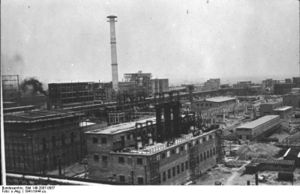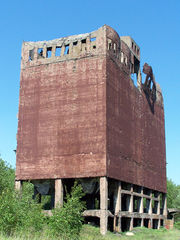IG Farben
 |
|
| Former type | Public |
|---|---|
| Industry | Chemicals |
| Fate | Liquidated |
| Predecessor | BASF, Bayer, Hoechst, Agfa, Griesheim-Elektron, Weiler Ter Meer |
| Successor | BASF, Bayer, Hoechst |
| Founded | December 25, 1925 |
| Defunct | 1952 |
| Headquarters | Frankfurt am Main |
I.G. Farbenindustrie AG was a German chemical industry conglomerate. Its name is taken from Interessen-Gemeinschaft Farbenindustrie AG (lit. Community of interest of the dye industry). The company was formed in 1925 from a number of major companies that had been working together closely since World War I. During its heyday IG Farben was the fourth-largest company in the world, after General Motors, U.S. Steel and Standard Oil. During the planning of the invasion of Czechoslovakia and Poland, IG Farben cooperated closely with Nazi officials and directed which chemical plants should be secured and delivered to IG Farben.[1]
Contents |
Founding members
IG Farben was founded on December 25, 1925 as a merger of the following six companies:[2]
- BASF
- Bayer
- Hoechst (including Cassella and Chemische Fabrik Kalle)
- Agfa
- Chemische Fabrik Griesheim-Elektron
- Chemische Fabrik vorm. Weiler Ter Meer
History
Predecessors of IG Farben
At the beginning of the 20th century the German chemical industry dominated the world market for synthetic dyes. The three major firms BASF, Bayer and Hoechst produced several hundred different dyes, along with the five smaller firms Agfa, Cassella, Chemische Fabrik Kalle, Chemische Fabrik Griesheim-Elektron and Chemische Fabrik vorm. Weiler-ter Meer concentrated on high-quality specialty dyes. In 1913 these eight firms produced almost 90 percent of the world supply of dyestuffs and sold about 80 percent of their production abroad.[3] The three major firms had also integrated upstream into the production of essential raw materials and they began to expand into other areas of chemistry such as pharmaceuticals, photographic film, agricultural chemicals and electrochemicals. Contrary to other industries the founders and their families had little influence on the top-level decision-making of the leading German chemical firms, which was in the hands of professional salaried managers. Because of this unique situation the economic historian Alfred Chandler called the German dye companies "the world's first truly managerial industrial enterprises".[4]
With the world market for synthetic dyes and other chemical products dominated by the German industry, German firms competed vigorously for market shares. Although cartels were attempted they lasted at most for a few years. Others argued for the formation of a profit pool or Interessen-Gemeinschaft (abbr. IG, lit. Community of interest).[5] In contrast, the chairman of Bayer, Carl Duisberg, argued for a merger. During a trip to the United States in the spring of 1903 he had visited several of the large American trusts such as Standard Oil, U.S. Steel, International Paper and Alcoa.[6] In 1904, after having returned to Germany he proposed a nationwide merger of the producers of dye and pharmaceuticals in a memorandum to Gustav von Brüning, the senior manager at Hoechst.[7] Hoechst and several pharmaceutical firms refused to join. Instead, Hoechst and Cassella made an alliance based on mutual equity stakes in 1904. This prompted Duisberg and Heinrich von Brunck, chairman of BASF, to accelerate their negotiations. In October 1904 an Interessen-Gemeinschaft between Bayer, BASF and Agfa was formed, also known as the Dreibund or little IG. Profits of the three firms were pooled, with BASF and Bayer getting 43 percent and Agfa 14 percent of all profits.[8] The two alliances were loosely connected with each other through an agreement between BASF and Hoechst to jointly exploit the patent on the Heumann-Pfleger indigo synthesis.[9]
Within the Dreibund Bayer and BASF concentrated on dye whereas Agfa increasingly concentrated on photographic film. Although there was some cooperation between the technical staff in production and accounting, there was little cooperation between the firms in other areas. Neither were production or distribution facilities consolidated nor did the commercial staff cooperate.[10] In 1908 Hoechst and Cassella acquired 88 percent of the shares of Chemische Fabrik Kalle. As Hoechst, Cassella and Kalle were connected by mutual equity shares and were located close to each other in the Frankfurt area, this allowed them to cooperate more successfully than the Dreibund, although they also did not rationalize or consolidate their production facilities.[10]
Foundation of IG Farben
IG Farben was founded on December 25, 1925 as a merger of the following six companies: BASF (27.4 percent of equity capital), Bayer (27.4 percent), Hoechst including Cassella and Chemische Fabrik Kalle (27.4 percent), Agfa (9.0 percent), Chemische Fabrik Griesheim-Elektron (6.9 percent) and Chemische Fabrik vorm. Weiler Ter Meer (1.9 percent). In 1926 IG Farben had a market capitalization of 1.4 billion Reichsmark and a workforce of 100,000 people, of which 2.6 percent were university educated, 18.2 percent were salaried professionals and 79.2 percent were workers.[2]
Similar mergers took place in other countries. In the United Kingdom Brunner Mond, Nobel Industries, United Alkali Company and British Dyestuffs merged to Imperial Chemical Industries in September 1926. In France Établissements Poulenc Frères and Société Chimique des Usines du Rhône merged to Rhône-Poulenc in 1928.[11]
The IG Farben Building, headquarters for the conglomerate in Frankfurt am Main, Germany, was completed in 1931.
In 1938 the company had 218,000 employees.[12]

World War II
During the planning of the invasion of Czechoslovakia and Poland, IG Farben cooperated closely with Nazi officials and directed which chemical plants should be secured and delivered to IG Farben.[1]
In 1941, an investigation exposed a "marriage" cartel between John D. Rockefeller's United States-based Standard Oil Co. and I.G. Farben.[13][14] (see[15] and[16]) It also brought new evidence concerning complex price and marketing agreements between DuPont, a major investor in and producer of leaded gasoline, U.S. Industrial Alcohol Co. and their subsidiary, Cuba Distilling Co. The investigation was eventually dropped, like dozens of others in many different kinds of industries, due to the need to enlist industry support in the war effort. However, the top directors of many oil companies agreed to resign, and oil industry stocks in molasses companies were sold off as part of a compromise worked out.[17][18][19]
IG Farben built a factory (named Buna Chemical Plant) that produced synthetic oil and rubber (from coal) at Auschwitz,[20] which was the beginning of SS activity and camps in this location during the Holocaust. At its peak in 1944, this factory made use of 83,000 slave laborers and prisoners.[21] The pesticide Zyklon B (infamous for its use in gas chambers during the Holocaust), for which IG Farben held the patent, was manufactured by Degesch (Deutsche Gesellschaft für Schädlingsbekämpfung), which IG Farben owned 42.2 percent of (in shares) and which had IG Farben managers in its Managing Committee.
Of the 24 directors of IG Farben indicted in the so-called IG Farben Trial (1947–1948) before a U.S. military tribunal at the subsequent Nuremberg Trials, 13 were sentenced to prison terms between one and eight years. Some of those indicted in the trial were subsequently made leaders of the post-war companies that split off from IG Farben, including those who were sentenced at Nuremberg.

Facilities during World War II
IG Farben facilities were bombing targets of the Oil Campaign of World War II, and up to 1941, there were 5 Nazi Germany Buna plants that produced Buna N by the Lebedev process.[22]:15
- Dwory
- After a contract was initiated by a March 2, 1942 contract with "IG Farbenindustrie AG Auschwitz",[1] the synthetic rubber and oil plant at Dwory (near Auschwitz III-Monowitz, which provided forced labor) was under construction in November 1943).[23] The Buna Chemical Plant) produced synthetic oil and rubber (from coal) was the beginning of SS activity and camps in this location during the Holocaust. At its peak in 1944, this factory made use of 83,000 slave laborers.[21] The pesticide Zyklon B (infamous for its use in gas chambers during the Holocaust), for which IG Farben held the patent, was manufactured by Degesch (Deutsche Gesellschaft für Schädlingsbekämpfung), which IG Farben owned 42.2 percent of (in shares) and which had IG Farben managers in its Managing Committee. Today, the plant operates as "Dwory S.A." [2]
- Frankfurt
- In addition to the "cavernous" IG Farben building at Frankfurt, a Hoechst AG chemical factory in Frankfurt was bombed by the RAF on September 26, 1944.
- Ludwigshafen and Oppau
- The I.G. Farbenindustrie, A. G., Works, Ludwigshafen and Oppau had several chemical plants.
- Pölitz, North Germany (today Police, Poland)
- In 1937, IG Farben, Rhenania-Ossag, and Deutsch-Amerikanische Petroleum Gesellschaft founded the Hydrierwerke Pölitz AG synthetic fuel plant.[24]:193ff By 1943, the plant produced 15% of Nazi Germany's synthetic fuels, 577,000 tons.[24]:196
- Waldenburg
- An IG Farben plant was at Waldenburg[25]:6
Break-up and liquidation
Due to the severity of the war crimes committed by IG Farben during World War II, the company was considered to be too corrupt to be allowed to continue to exist. The Soviet Union seized most of IG Farben's assets located in the Soviet occupation zone (see Morgenthau Plan), as part of their reparation payments. The Western Allies however, in 1951, split the company up into its original constituent companies. The four largest quickly bought the smaller ones. Today only Agfa, BASF, and Bayer remain, Hoechst having in 1999 demerged its industrial chemical operations to Celanese AG and merged its life-sciences businesses with Rhône-Poulenc's to form Aventis.
Part of Hoechst was afterwards Celanese AG, while another part of the company was sold in 1997 to the chemical spin-off of Sandoz, the Muttenz (Switzerland) based Clariant.
Even though IG Farben was officially liquidated in 1952, it continued to be traded on the Frankfurt Stock Exchange as a trust company, holding a few real estate assets until it was finally wound up on November 10, 2003 by its liquidators. It had contributed 500,000 DM (£160,000 or €255,646) towards a foundation for former captive laborers under the Nazi regime. The remaining property, worth DM 21 million (£6.7 million or €10.7 million), went to a buyer. During this lengthy period, the holding company had been continually criticized for failing to pay any compensation to the former laborers, which was the stated reason for its continued existence after 1952. The company, in turn, blamed the ongoing legal disputes with the former captive laborers as being the reason it could not be legally dissolved and the remaining assets distributed as reparations. Nevertheless, it refused to join a national compensation fund that was set up in 2001 to pay people who had suffered.[26] Each year, the company's annual meeting in Frankfurt was the site of demonstrations by hundreds of protesters.[27]
Patents and scientific know-how
Once Germany had surrendered the US moved quickly to commercially exploit all German patents and scientific know-how. (see Industrial plans for Germany)
Konrad Adenauer stated "According to a statement made by an American expert, the patents formerly belonging to IG Farben have given the American chemical industry a lead of at least 10 years. The damage thus caused to the German economy is huge and cannot be assessed in figures. It is extraordinarily regrettable that the new German inventions cannot be protected either, because Germany is not a member of the Patent Union. Britain has declared that it will respect German inventions regardless of what the peace treaty may say. But America has refused to issue such a declaration. German inventors are therefore not in a position to exploit their own inventions. This puts a considerable brake on German economic development."[28]
Products
Synthetic dyes, Nitrile rubber, Polyurethane, Prontosil, Resochin, Zyklon B, among others.
IG Farben scientists made fundamental contributions to all areas of chemistry. Otto Bayer discovered the polyaddition for the synthesis of polyurethane in 1937.[29] Several IG Farben scientists were awarded a Nobel Prize. Carl Bosch and Friedrich Bergius were awarded the Nobel Prize in Chemistry in 1931 "in recognition of their contributions to the invention and development of chemical high pressure methods".[30] Gerhard Domagk was awarded the Nobel Prize in Physiology or Medicine in 1939 "for the discovery of the antibacterial effects of prontosil".[31] Kurt Alder was awarded the Nobel Prize in Chemistry (together with Otto Diels) in 1950 "for his [their] discovery and development of the diene synthesis".[32]
Bankruptcy
Minor parts from what was once called IG Farben may still be operative as AG Farben. AG stands for Aktien Gesellschaft, a term to designate the legal status of a business company.
IG Farben in fiction
- Der Rat der Götter ("The Council of the Gods") (DEFA 1951, director Kurt Maetzig) is an East German film about IG Farben's role in World War II and the subsequent trial. See: Rat der Götter, Der at the Internet Movie Database
- IG Farben plays a prominent role in Thomas Pynchon's novel, Gravity's Rainbow, primarily as the manufacturer of the elusive and mysterious plastic product "Impolex G."
- IG Farben plays a prominent role in Philip K. Dick's alternative history novel The Man in the High Castle.
- IG Farben is the company said to be supporting German terror activities and research of uranium ores in Brazil after World War II in Alfred Hitchcock's film noir Notorious, 1946
- The film Heartbeat Detector (2007) by Nicolas Klotz is based in a company called SC Farb
See also
- IG Farben Building
- IG Farben Trial
- Monowitz concentration camp
- American IG
References
- ↑ 1.0 1.1 Profit Over Life | The Nuremberg Pharma Tribunal | www.pharma-over-life.org
- ↑ 2.0 2.1 Tammen 1978, p. 195
- ↑ Aftalion 1991, p. 104, Chandler 2004, p. 475
- ↑ Chandler 2004, p. 474–485
- ↑ Chandler 2004, p. 479
- ↑ Beer 1981, p. 124–125
- ↑ Duisberg, Carl (in German), Denkschrift über die Vereinigung der deutschen Farbenfabriken (Abhandlungen, Vorträge und Reden aus den Jahren 1882–1921 ed.), Berlin, pp. 343–369
- ↑ Beer 1981, p. 125–134
- ↑ Tammen 1978, p. 11
- ↑ 10.0 10.1 Chandler 2004, p. 480
- ↑ Aftalion 1991, p. 140, 143
- ↑ Fiedler, Martin (1999), "Die 100 größten Unternehmen in Deutschland - nach der Zahl ihrer Beschäftigten - 1907, 1938, 1973 und 1995" (in German), Zeitschrift für Unternehmensgeschichte (Munich: Verlag C.H. Beck) 1: 32–66
- ↑ Trading With the Enemy (1983), Charles Higham: Delacorte Press, New York NY; Pp. 32 - 62 ISBN 0-440-09064-4
- ↑ Wall Street and the Rise of Hitler (2000) By Antony C. Sutton]
- ↑ Facts and Fascism (1943) by George Seldes
- ↑ The Senate Military Affairs Subcommittee on War Mobilization (Kilgore Committee), headed by Senator Harley M. Kilgore, held several hearings throughout the second half of 1945 that focused on German economic penetration of neutral countries, elimination of German resources for war, German's resources for a third world war, etc. Archives are at NARA's Center for Legislative Archives in the Archives I building. See the National Archives finding aid for Holocaust research.
- ↑ World Without Cancer: The Story of Vitamin B17 (Laetrile) (1974-1975) by G. Edward Griffen
- ↑ I.G. Farben (1947) by Richard Sasuly
- ↑ Wall Street and the Rise of Hitler (2000) By Antony C. Sutton, a book that describes in detail the money trail from its roots to the bank accounts of the Nazi SS.
- ↑ Wagner-Kyora, Georg (2009), Vom "nationalen" zum "sozialistischen" Selbst: zur Erfahrungsgeschichte deutscher Chemiker und Ingenieure im 20. Jahrhundert, Stuttgart: Steiner, ISBN 9783515092623
- ↑ 21.0 21.1 http://www.profit-over-life.org/rolls.php?roll=97&pageID=760&expand=no IG Farben Trial Documents
- ↑ "Summaries: Microfilm 2, U.S. Government Technical Oil Mission" (pdf). pp. 15 pdf pages (last numbered 14). http://www.fischer-tropsch.org/Tom%20Reels/Linked/TOM%20143/TOM-143-0028-0042%20Reel%202%20Summaries.pdf. Retrieved 2009-05-21. Table of Contents
- ↑ HQ. U.S.S.T.A.F. (5th MARCH 1944), "Appendix F", Plan for Completion of Combined Bomber Offensive (Dwight D. Eisenhower Presidential Library: SMITH, WALTER BEDELL: Collection of World War II Documents, 1941-1945; Box No.: 48: HQ, U.S.S.T.A.F), "MOST SECRET … DECLASSIFIED … 4/4/74"
- ↑ 24.0 24.1 (German)Karlsch, Raymond G (2003), Faktor Öl: die Mineralölwirtschaft in Deutschland 1859-1974, C.H.Beck, pp. 193ff,196, ISBN 3406502768
- ↑ "Summaries: Microfilm 2, U.S. Government Technical Oil Mission" (pdf). fischer-tropsch.org. pp. 15 pdf pages. http://www.fischer-tropsch.org/Tom%20Reels/Linked/TOM%20143/TOM-143-0028-0042%20Reel%202%20Summaries.pdf. Retrieved 2009-05-21.
- ↑ Former Zyklon-B maker goes bust BBC News Online November 10, 2003. Accessed March 27, 2008.
- ↑ IG Farben to be dissolved BBC News Online September 17, 2001. Accessed March 27, 2008.
- ↑ Konrad Adenauer, "Memoirs", Volume 1, p.148 (1966)
- ↑ Nicholson, John W. (2006), The Chemistry of Polymers, London: Royal Society of Chemistry, pp. 61, ISBN 0854046844
- ↑ The Nobel Prize in Chemistry 1931, Nobel Foundation, http://nobelprize.org/nobel_prizes/chemistry/laureates/1931/index.html, retrieved 2008-10-27
- ↑ The Nobel Prize in Physiology or Medicine 1939, Nobel Foundation, http://nobelprize.org/nobel_prizes/medicine/laureates/1939/, retrieved 2008-10-27
- ↑ The Nobel Prize in Chemistry 1950, Nobel Foundation, http://nobelprize.org/nobel_prizes/chemistry/laureates/1950/index.html, retrieved 2008-10-27
Bibliography
- Aftalion, Fred; Otto Theodor Benfey (1991), A History of the International Chemical Industry, Philadelphia, PA: University of Pennsylvania Press, ISBN 0812282078
- Beer, John Joseph (1981), The Emergence of the German Dye Industry, Manchester, NH: Ayer Company Publishers, ISBN 0405138350
- Borkin, Joseph (1978), The Crime and Punishment of I.G. Farben, New York, London: The Free Press, division of Macmillan Publishing Co., ISBN 0-02-904630-0
- Borkin, Joseph (1990) (in German), Die unheilige Allianz der IG Farben. Eine Interessengemeinschaft im Dritten Reich, Frankfurt am Main: Campus Verlag, ISBN 3593342510
- Chandler, Alfred DuPont (2004), Scale and Scope: The Dynamics of Industrial Capitalism, Cambridge, MA: Belknap Press of Harvard University Press, ISBN 0674789954
- Kreikamp, Hans-Dieter (1977), "Die Entflechtung der I.G. Farbenindustrie A.G. und die Gründung der Nachfolgegesellschaften" (in German), Vierteljahrshefte für Zeitgeschichte (Munich: Oldenbourg Verlag) 25 (2): 220–251, http://www.ifz-muenchen.de/heftarchiv/1977_2.pdf, retrieved 2008-10-27
- Plumpe, Gottfried (1990) (in German), Die I.G. Farbenindustrie AG: Wirtschaft, Technik und Politik 1904–1945 (Schriften zur Wirtschafts- und Sozialgeschichte ed.), Berlin: Duncker & Humblot, ISBN 3428068920
- Tammen, Helmuth (1978) (in German), Die I.G. Farbenindustrie Aktiengesellschaft (1925-1933): Ein Chemiekonzern in der Weimarer Republik, Berlin: H. Tammen, ISBN 3883440019
External links
- Official homepage of the IG Farben successor BASF
- Official homepage of the IG Farben successor Bayer
- Official homepage of the IG Farben successor Hoechst (now Sanofi-Aventis)
|
|||||||||||||||||